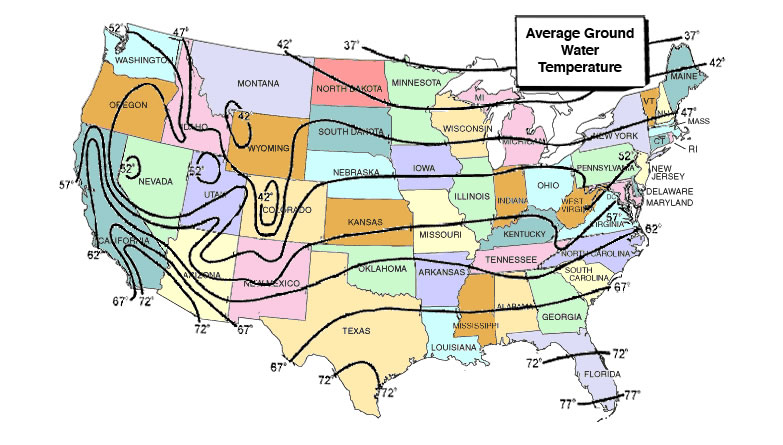
 |
|
|
|
|
#1 |
|
Apprentice EcoRenovator
Join Date: Oct 2014
Location: SE MI
Posts: 105
Thanks: 3
Thanked 12 Times in 9 Posts
|
Areas like the U.P. of MI, northern MN, ME, ND and most of Canada get deep frost, at last 48". These areas obviously warm up enough in summer so that the ground (eventually) does melt.
Are deep vertical wells a reasonable source of "heat" for geothermal heat pumps ? Most vertical GSHP don't see "stabilized" temperatures until at least 20'. For these colder climates, I suspect that is more like 40-50'. If the pipes are well insulated from that depth all the way to the heat pump, would that be adequate ? |
|
|

|
|
|
#2 | |
|
Supreme EcoRenovator
Join Date: Mar 2009
Location: Portland, OR
Posts: 4,004
Thanks: 303
Thanked 723 Times in 534 Posts
|
Quote:
You should consult some local GSHP installers, they would have exactly the information you are looking for. I doubt that anyone on this forum actually has this information. I hope that when you find out, you'll let us know. Best, -AC_Hacker
__________________
I'm not an HVAC technician. In fact, I'm barely even a hacker... |
|
|
|

|
|
|
#3 |
|
Apprentice EcoRenovator
Join Date: Oct 2014
Location: SE MI
Posts: 105
Thanks: 3
Thanked 12 Times in 9 Posts
|
|
|
|

|
|
|
#4 | |
|
Supreme EcoRenovator
Join Date: Mar 2009
Location: Portland, OR
Posts: 4,004
Thanks: 303
Thanked 723 Times in 534 Posts
|
Quote:
-AC
__________________
I'm not an HVAC technician. In fact, I'm barely even a hacker... |
|
|
|

|
|
|
#5 |
|
Master EcoRenovator
Join Date: Aug 2012
Location: Toronto
Posts: 958
Thanks: 40
Thanked 158 Times in 150 Posts
|
I remember one particularly bad year back in 93 (I think) when the weather was cold enough that the water lines 7ft down were freezing. That is rare but I don't remember ever hearing of building footings having an issue at 4ft. I would guess that you would have stable temps from 10' down or at least no possibility of freezing. Thing is, you have 500ft of tubing in one hole so the 10ft or so at the top won't affect the output much.
That number will be different in the far north tho. The number may be 20ft. |
|
|

|
|
|
#6 |
|
Apprentice EcoRenovator
Join Date: Oct 2014
Location: SE MI
Posts: 105
Thanks: 3
Thanked 12 Times in 9 Posts
|
I was reading on another forum about folks who had installed horizontal loops at 12-15' deep, actually getting inlet water from their loop well below freezing ! Sure, it has been cold in the Midwest USA, with temps below 0F, but if your inlet water temp is below freezing, IMHO, you have a SERIOUS design/installation flaw !
|
|
|

|
|
|
#7 |
|
Apprentice EcoRenovator
Join Date: Oct 2014
Location: SE MI
Posts: 105
Thanks: 3
Thanked 12 Times in 9 Posts
|
|
|
|

|
|
|
#8 |
|
Apprentice EcoRenovator
Join Date: Oct 2014
Location: SE MI
Posts: 105
Thanks: 3
Thanked 12 Times in 9 Posts
|
Well, I sort of, kind of got the information I was looking for (perhaps I did not phrase the question well to begin with).
First, if you Google around you can find charts similar to this one from www.texas-geology.com/  The important data here is that soil temperature stabilizes at about 30'. I have not found a chart that shows deeper reading, but I am fairly certain the do not shift much (although I would still like to see readings down to say 200' if anyone has access to them !) This chart is from TX, so the center point is pretty high (70F !). This map from www.hotspotenergy.com shows the average ground water temperature in different parts of the US. I a pretty certain that these numbers line up with the center of the above graph.  So my conclusion is that GSHP are not as big of a "win" for heating and cooling in far northern and southern areas. This surprised me ! I thought below some reasonable depth (20-30') that all ground water (at least water not heated by some geological "feature") was about 50-60F REGARDLESS of what latitude ! Anecdotal evidence is welcome ! |
|
|

|
|
|
#9 | |
|
DIY Geek
Join Date: Apr 2013
Location: Sunny Florida
Posts: 401
Thanks: 74
Thanked 83 Times in 73 Posts
|
Quote:
Nice map, btw. I needed that info. |
|
|
|

|
|
|
#10 |
|
Lurking Renovator
Join Date: Jan 2014
Location: Rhode Island
Posts: 5
Thanks: 0
Thanked 1 Time in 1 Post
|
Most GSHP's have performance charts which rate them at x BTU's at -1*C (30*F) for heating and 32*C (90*F) cooling.
A well designed loop (performance and cost) will get down to -1*C by the end of the heating season. To gain 1* or 2* can cost 75% to 100% more in upfront costs, not to mention the additional pumping costs for the life of the loop. -10*C is not typical, most are only freeze protected to -9*C. CJ |
|
|

|
 |
| Thread Tools | |
| Display Modes | |
|
|